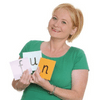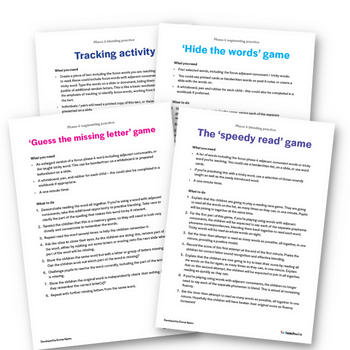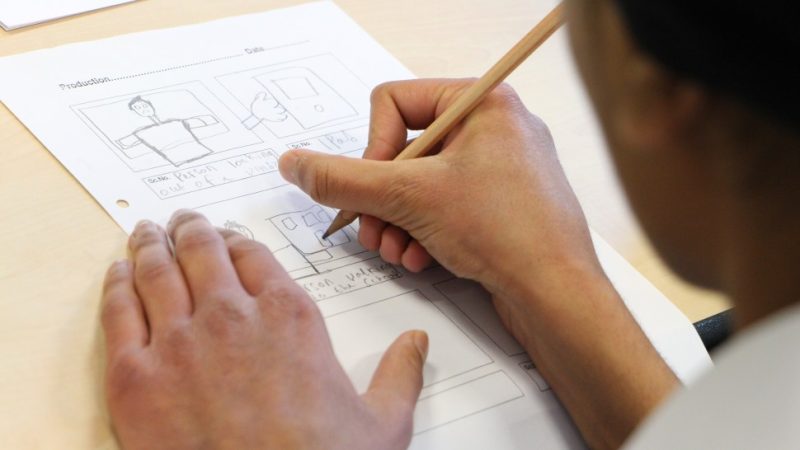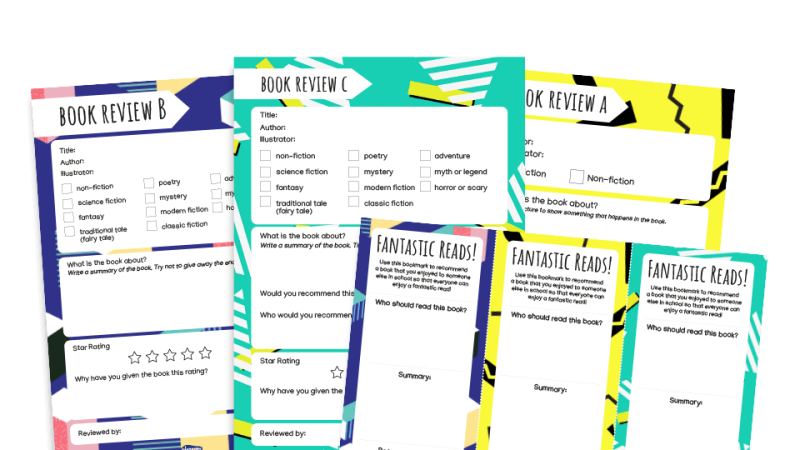Phase 4 phonics – how to teach them, and games ideas

Conquer blending, segmenting, tricky words and planning with this guide to building on previous learning

- by Emma Spiers

Phase 4 phonics can feel trickier to teach than phonics phases 2 and 3, because there are no new letter-sound correspondences (grapheme-phoneme correspondences) to learn.
This is a teaching phase designed to consolidate and build on all previous learning, challenging children to read longer words, and a larger bank of tricky words, ‘at a glance’.
Put simply, phase 4 phonics is all about building children’s confidence and capacity to read more words.
They will be applying these in slightly longer sentences, using the letter-sound correspondences that they already know.
Jump to section
- Phase 4 phonics sounds
- Phase 4 phonics activities
- Polysyllabic words
- A common misconception
- Phase 4 phonics planning
- Phase 4 phonics sound mats
- Blending and segmenting with adjacent consonants
- Phase 4 phonics games
- Applying phase 4 phonics
- Tricky words phase 4
- Top tips for teaching tricky words
- The impact of phase 4 phonics
Phase 4 phonics sounds
Before beginning phase 4 phonics, children should be able to read, find and write all the letter-sound (grapheme-phoneme) correspondences taught in phases 2 and 3 which will include:
S, a, t, p, i, n, m, d, o, c, k, ck, e, u, r, h, b, f, ff, l, ll, ss, j, v, w, x, y, z, zz, qu, ch, sh, th, ng, ai, ee, igh, oa, oo, ar, or, ur, ow, oi, er, ear, air, ure
Children should be able to blend-to-read – and segment-to-spell – CVC (consonant-vowel-consonant) words using these correspondences.
We also want them to be able to independently read and write captions and simple sentences including these words.
The phase 2 and 3 common exception words that children beginning phase 4 phonics should already be able to read will include:
I, the, no, go, to, he, be, we, me, she, was, my, you, they, her, all, are
Phase 4 phonics activities
All phase 4 phonics activities should include lots of opportunities to blend-to-read, and segment-to-spell words including adjacent consonants, and words of more than one syllable, including:
- CVCC words
consonant-vowel-consonant-consonant
For example: milk, desk, went, last, soft, chest, shelf, toast
- CCVC words
Consonant-consonant-vowel-consonant
For example: from, stop, plan, frog, flag, grab, green, brush, sport, crash
- CCVCC words
Consonant-consonant-vowel-consonant- consonant
For example: stand, spend, trust, twist, blink, crunch, shrink
- CCCVC words
Consonant-consonant-consonant- vowel-consonant
For example: splash, spring, street, string
It’s important to remember that the vowel digraphs and consonant digraphs taught in phase 3 are included in these words as a whole unit.
For example:
b-r-u-sh is a CCVC word. The digraph sh is made of consonants and is considered as a single consonant unit in this word.
g-r-ee-n is a CCVC word. The digraph ee is made of vowels and is considered as a single vowel unit in this word.
Polysyllabic words
Polysyllabic words are words with more than one syllable.
Examples of two-syllable words taught in phase 4 phonics include:
child-ren, sham-poo, lunch-box, float-ing, twirl-ing, sun-light, print-er
Examples of three-syllable words taught in phase 4 phonics include:
thun-der-ing, chimp-an-zee
A common misconception
Phase 4 phonics is written using a synthetic phonics approach.
Unlike alternative methods of teaching phonics, the words containing adjacent consonants are not taught as blends or separate units to be remembered in isolation.
The aim of phase 4 phonics is to continue developing the process of blending as in previous phases.
Unlike alternative approaches where children need to learn numerous combinations of blends, this reduces the amount of information children need to memorise.
The focus is on perfecting a skill that pupils have already started to develop, making the process of learning to read more efficient and arguably more effective.
Phase 4 phonics planning
All phase 4 phonics planning should follow the same routine and simple teaching sequence.
This reduces the cognitive load in the working memory, enabling children to engage fully with improving the processes of blending and segmenting with more complex words.
With cognitive load in mind, a systematic and simplified approach is recommended, blending and segmenting with one particular combination of adjacent consonants in each lesson.
For example:
Day 1: words with the adjacent consonants b-r; brush, bright, bring, broomstick
Day 2: words with the adjacent consonants s-t; step, stop, stand, stamp, stink
Day 3: words with the adjacent consonants f-l; flap, flop, flash, flight, flicker
Phase 4 phonics sound mats
Begin each lesson by revising previously taught grapheme-phoneme correspondences.
Pace is crucial here as this is an exercise in memory retrieval, helping children to access previously acquired knowledge, upon which they are about to build.
Useful resources can include flashcards or phase 4 phonics sound mats.
- Use the flashcards to call out the phoneme (sound) matched to the grapheme (letter) all together.
- Use sound mats to rapidly find the grapheme (letter/letters) as an adult says the phoneme (sound) aloud.
As the children will know all the previously taught phase 2 and phase 3 letter-sound correspondences (GPCs), it’s not necessary to revise all of these during each lesson.
Focus on correspondences that you have most recently taught, or that they are struggling to remember.
Blending and segmenting with adjacent consonants
We also need to show children how to hear the adjacent consonants in words. They often find these tricky to determine as some phonemes (sounds) are more dominant in words.
For example: hearing went as wet; missing out the ‘n’, as it is the most subtle phoneme (sound).
We also need to show pupils how to say the adjacent consonants in words. This can be tricky, depending on clarity of speech.
For example: saying jum rather than drum; chain rather than train; or vat rather than that.
To achieve success in this area, begin by orally blending and segmenting the chosen words as a class.
Use strategies consistent with those already introduced in phases 2 and 3 phonics lessons, and don’t initially read or write anything.
Teach children to blend the chosen words together, following the ‘I do, we do, you do’ method:
- The adult models the blending process first (I do)
- Children and adult blend aloud together (we do)
- Children blend independently as a class (you do)
Keep the number of words limited to no more than eight, using the focus consonants for the session.
Repeat this process by segmenting to spell the same words, using the same methodology.
Phase 4 phonics games
Children find the blending and segmenting processes much more challenging than simply remembering the letter-sound correspondences.
These are skills, so require plenty of daily practise. It’s important that lots of active and engaging learning is incorporated, for meaningful repetition and reinforcement.
For blending you could try:
The Speedy Ready game
Tracking activity
For segmenting you could try:
Hide the word game
Guess the missing letter game
Full instructions for these games are available in the free download with this article.
You’ll need to play these games over and over again, changing the words in each lesson to match the adjacent consonants you’ve chosen to teach.
Applying phase 4 phonics
It’s important that children learn to apply phase 4 phonics beyond the isolated word level, because the aim is for them to use this knowledge as they read and write.
Every phase 4 phonics lesson should therefore include explicit teaching of how to read or write a sentence, including some of the focus words explored during the lesson.
This could consist of shared sentence-reading, or dictated sentence-writing, using the ‘I do, we do, you do’ strategy previously mentioned.
Another useful strategy is to read or write all together as a class, blending or segmenting one word at a time.
As each word is read aloud or written, the group should be guided back to the beginning of the sentence to reread previous words.
This will significantly improve memory, training the children to check that what they are reading or writing makes sense.
Things to avoid:
- Asking the children to think of their own sentences to write
The objective is for the children to apply the words taught in a sentence, with a high degree of accuracy in spelling. Thinking of a sentence requires the children to think of much more than just that, stepping beyond the purpose of the lesson.
- Expecting the children to read or write without a model
This part of the teaching sequence is not an opportunity to assess the success of the lesson. It’s a chance to over-model and clearly demonstrate how learning can be applied in reading and writing beyond the phonics session.
Tricky words phase 4
There are many new tricky words to introduce in phase 4 phonics.
These include:
said, so, have, like, some, come, were, there, little, one, do, when, out, what
Top tips for teaching tricky words
There are many new tricky words to introduce in phase 4 phonics.
These include: said, so, have, like, some, come, were, there, little, one, do, when, out, what.
Using flashcards is a great strategy for some children with good visual memory, as is teaching mnemonics (for example, silly ants in dresses), but neither are universally successful.
If you’re having trouble, why not try:
- Unpicking each word explicitly in a lesson
Explain that there are parts of the tricky word which aren’t so tricky. This reduces the overwhelm required in simply ‘just learning’ a word. For example, s and d in said are fully decodable; nothing tricky there.
- Explicitly teaching the tricky part
Explain that the children only need to remember the tricky part in the word. For example, that ai in said looks like ai in rain, but in this word, it’s making an e sound instead.
The impact of phase 4 phonics
By the end of phase 4 phonics teaching, children will be able to:
- blend to read words including adjacent consonants taught in phase 2 and phase 3;
- segment to spell words including adjacent consonants taught in phase 2 and phase 3;
- read two-syllable words including letter-sound correspondences taught in phase 2 and phase 3;
- read all tricky words taught in phase 4;
- apply phase 4 learning when reading and writing sentences.
Children secure at this phase will have a good foundational knowledge of the basic alphabetic code.
This means that they will have a solid basis for successfully exploring the complexities of the alphabetic code taught in phonics phase 5 and beyond.
Emma Spiers is an author, early literacy consultant and trainer. Follow her on Twitter @learningladyuk and see more of her work at learninglady.co.uk











